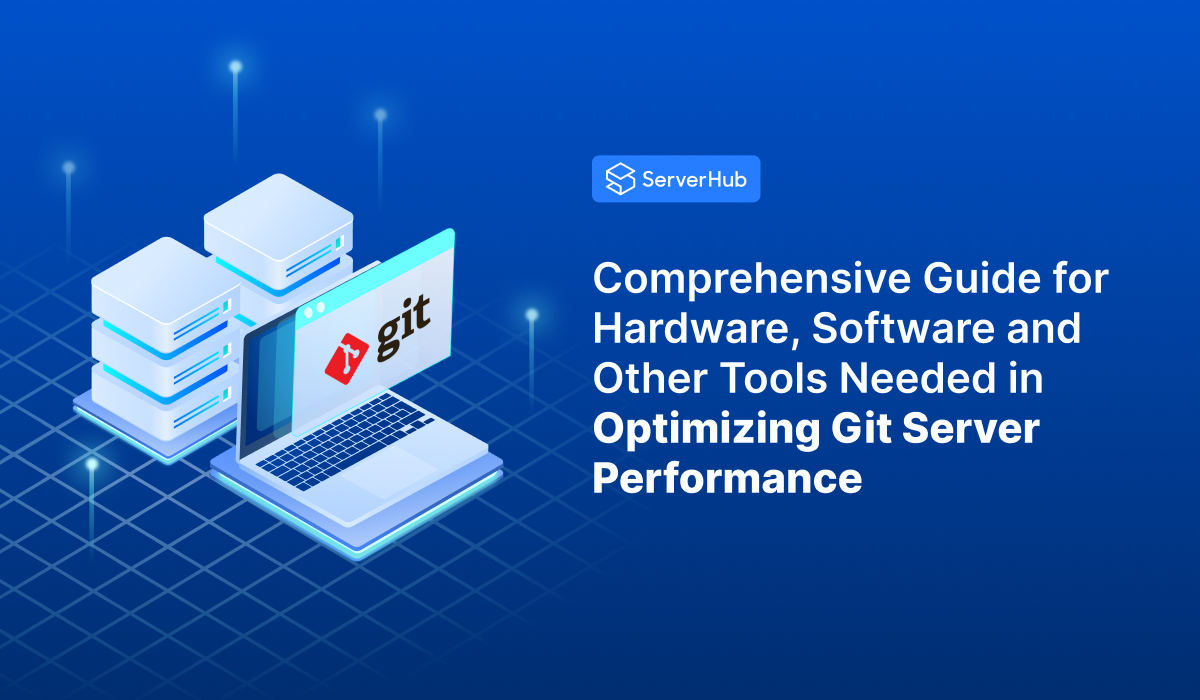Git is an open-source version control system. It is widely used in software development for tracking changes in code, collaborating with team members, and managing project versions. A Git server is a centralized platform where Git repositories are hosted and managed. It acts as a hub, allowing multiple developers to push, pull, and merge code from various branches, ensuring that projects are synchronized and up-to date.
In this article, we will discuss the advantages of using a Git server and the importance of optimizing its performance. We will also tackle the hardware, software and other tools needed for Git server optimization.
The Importance of Optimizing Git Server Performance
The following are some of the reasons why Git server optimization is important:
1. Enhanced developer activity: Poor Git server performance can cause delays in cloning, pushing, and pulling code, leading to developer frustration and lost time. Optimization ensures a seamless experience, allowing developers to focus on their work without interruption.
2. Reduced downtime: Optimized Git servers experience fewer performance-related issues, reducing the likelihood of downtime that can affect an entire team’s workflow.
3. Scalability: As your organization scales, the Git server must handle increased traffic, larger repositories, and more users. Optimizing the server ensures that it can handle such growth without significant performance degradation.
4. Cost-efficient: Git server efficiency reduces the need for frequent hardware upgrades and additional resources, minimizing costs associated with over-provisioning and underutilization.
Hardware and Infrastructure for Optimizing Performance of Git Servers
The hardware and infrastructure play a crucial role in determining Git server efficiency. The key components and practices that ensure optimal Git server performance:
Server Hardware
1. CPU: A powerful multi-core CPU helps handle multiple simultaneous operations such as commits, merges, and repository clones. High clock speed improves the server's ability to process tasks quickly, while multi-threading enhances concurrency.
2. RAM: Sufficient memory is necessary for Git servers to handle large repositories and multiple operations concurrently. Insufficient RAM can result in slow queries and sluggish performance when accessing large repositories.
3. Disk I/O: Since Git operations are heavily dependent on disk input/output (I/O), using SSDs (Solid State Drives) can dramatically improve repository cloning, checkout, and other file operations. For large-scale systems, RAID setups may offer redundancy and increased speed.
4. Network bandwidth: A fast, reliable network connection is essential to support the upload and download of large repositories, especially for remote developers or teams working across multiple geographies. Having gigabit or higher network speeds can prevent bottlenecks during cloning or pushing operations.
Infrastructure Considerations
1. Load balancers: In high-traffic environments, load balancers can distribute traffic across multiple Git server instances to prevent any single server from becoming overwhelmed.
2. Caching solutions: Implementing a caching system for commonly accessed repositories can reduce the load on your primary server and accelerate access times for users.
3. Backup and redundancy: Regular backups and redundant setups (e.g., using multiple data centers) ensure that the Git server remains available even in the event of hardware failure or data corruption.
Software and Monitoring Tools for Optimizing Git Servers
Beyond hardware, software optimizations and continuous monitoring are key to maintaining a high-performance Git server. Below are some strategies and tools that can enhance Git server efficiency:
1. Git Garbage Collection (GC): Over time, Git repositories accumulate unnecessary objects and references that can bloat their size and slow down performance. Running Git's built-in garbage collection (git gc) periodically removes these unused objects, which reduces the size of repositories and improving overall performance.
2. Repository splitting: For large projects with extensive histories, consider splitting the repository into smaller, more manageable sub-repositories. This reduces the size of each repository, making cloning, pulling, and pushing faster and more efficient.
3. Branch management: Keeping a clean repository by archiving or deleting stale branches is important for maintaining speed. A high number of inactive branches can increase the time it takes to fetch or pull changes, impacting Git server efficiency.
4. Monitoring tools: Monitoring Git server performance in real-time allows administrators to identify potential bottlenecks and take corrective action. Some popular tools for monitoring include:
* Prometheus with Grafana: This combination offers advanced monitoring capabilities, displaying server performance metrics such as CPU usage, memory consumption, and network traffic.
* Gitlab monitoring: For GitLab servers, GitLab provides built-in monitoring tools that track repository performance and alert administrators about any issues.
* ELK Stack (Elasticsearch, Logstash, Kibana): This toolset enables comprehensive logging and performance monitoring of your Git server. Elasticsearch indexes logs, Logstash processes them, and Kibana provides visualization, allowing you to analyze server performance over time.
* Automated alerts: Setting up automated alerts for key performance metrics, such as high CPU usage or low disk space, ensures that administrators can address issues before they impact server performance.
Why Optimizing a Git Server’s Performance is Crucial
Optimizing a Git server is essential for maintaining efficiency, especially as projects and teams grow in complexity and size. By focusing on both the hardware and software aspects of Git server optimization, you can ensure that your development environment remains responsive, scalable, and cost-efficient.
With the right infrastructure, monitoring tools, and maintenance practices in place, you can avoid bottlenecks, reduce downtime, and keep your development teams productive. By implementing the strategies outlined in this article, you can significantly improve Git server performance, making it more efficient, scalable, and reliable for your development teams.
Dedicated Servers from ServerHub
ServerHub's dedicated servers provide a robust platform for hosting Git servers, meeting the diverse needs of clients who require reliable and high-performance infrastructure for their repositories. ServerHub’s 24/7/365 support guarantees assistance whenever needed, and the 100% uptime guarantee provides peace of mind that the Git server will remain accessible. Contact us now to know more about our dedicated servers and other hosting solutions.
